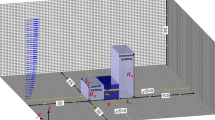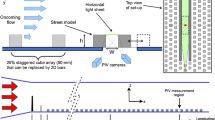Abstract
A step-up street canyon is a characteristic urban element composed of two buildings in which the height of the upwind building (\(H_\mathrm{u}\)) is less than the height of the downwind building (\(H_\mathrm{d}\)). Here, the effect of canyon geometry on the flow structure in isolated step-up street canyons is investigated through isothermal wind-tunnel measurements. The measurements were acquired along the vertical symmetry plane of model buildings using two-dimensional particle image velocimetry (PIV) for normal approach flow. The building-height ratios considered were: \(H_\mathrm{d}/ H_\mathrm{u} \approx 3\), and \(H_\mathrm{d}/ H_\mathrm{u} \approx 1.67\). For each building-height ratio, the along-wind lengths (L) of the upwind and downwind buildings, and the street-canyon width (S) were kept constant, with \(L \approx S\). The cross-wind widths (W) of the upwind and downwind buildings were varied uniformly from \(W/S \approx 1\) through \(W/S \approx 4\), in increments of \(W/S \approx 1\). The objective of the work was to characterize the changes in the flow structure in step-up canyons as a function of W/S, for fixed L, S, and \(H_\mathrm{d}/H_\mathrm{u}\) values. The results indicate that the in-canyon flow structure does not vary significantly for \(H_\mathrm{d}/H_\mathrm{u} \approx 3\) for the W/S values considered. Qualitatively, for \(H_\mathrm{d}/H_\mathrm{u} \approx 3\), the upwind building behaves as an obstacle in the upwind cavity of the downwind building. In contrast, the flow patterns observed for the \(H_\mathrm{d}/H_\mathrm{u} \approx 1.67\) configurations are unique and counter-intuitive, and depend strongly on building width (W/S). For \(W/S \approx 1\) and \(W/S \approx 2\), the effect of lateral flow into the canyon is so prominent that even the mean flow patterns are highly ambiguous. For \(W/S \approx 3\) and 4, the flow along the vertical symmetry plane is more shielded from the lateral flow, and hence a stable counter-rotating vortex pair is observed in the canyon. In addition to these qualitative features, a quantitative analysis of the mean flow field and turbulence stress field is presented.














Similar content being viewed by others
References
Addepalli B, Pardyjak ER (2007) Study of flow fields in asymmetric step-down street canyons. In: The international workshop on physical modelling of flow and dispersion phenomena (PHYSMOD 2007), University of Orleans, France
Allwine KJ, Flaherty JE (2006a) Joint urban 2003: study overview and instrument locations. Tech. Rep. PNNL-15967, Pacific Northwest National Laboratory, 92 pp
Allwine KJ, Flaherty JE (2006b) Urban dispersion program MSG05 field study: summary of tracer and meteorological measurements. Tech. Rep. PNNL-15969, Pacific Northwest National Laboratory, 27 pp
Allwine KJ, Flaherty JE (2007) Urban dispersion program overview and MID05 field study summary. Tech. Rep. PNNL-16696, Pacific Northwest National Laboratory, 63 pp
Allwine KJ, Shinn JH, Streit GE, Clawson KL, Brown MJ (2002) Overview of urban 2000: a multiscale field study of dispersion through an urban environment. Bull Am Meteorol Soc 83(4):521–536
Assimakopoulos VD, ApSimon HM, Moussiopoulos N (2003) A numerical study of atmospheric pollutant dispersion in different two-dimensional street canyon configurations. Atmos Environ 37(29): 4037–4049
Baik JJ, Park RS, Chun HY, Kim JJ (2000) A laboratory model of urban street-canyon flows. J Appl Meteorol 39(9):1592–1600
Beychok MR (2005) Fundamentals of stack gas dispersion, 4th edn. M.R. Beychok, Irvine, 193 pp
Camelli FE, Hanna SR, Löhner R (2004) Simulation of the MUST field experiment using the feflo-urban cfd model. In: 8th annual George Mason University conference on atmospheric transport and dispersion modeling, Fairfax, VA, pp 531–544
Chan ST, Leach MJ (2007) A validation of FEM3MP with Joint Urban 2003 Data. J Appl Meteorol Clim 46(12):2127–2146
Chang CH (2001) Numerical and physical modeling of bluff body flow and dispersion in urban street canyons. J Wind Eng Ind Aerodyn 89(14):1325–1334
Chang CH (2003) Concentration and flow distributions in urban street canyons: wind tunnel and computational data. J Wind Eng Ind Aerodyn 91(9):1141–1154
Coirier WJ, Kim S (2006) CFD modeling for urban area contaminant transport and dispersion: Model description and data requirements. In: Sixth symposium on urban environment, 86th AMS Annual Meeting, Atlanta, GA, 11 pp
Cui Z, Cai X, J Baker C (2004) Large-eddy simulation of turbulent flow in a street canyon. Q J R Meteorol Soc 130(599):1373–1394
DePaul FT, Sheih CM (1986) Measurements of wind velocities in a street canyon. Atmos Environ 20(3):455–459
Gowardhan A, Pardyjak ER, Senocak I, Brown MJ (2007) Investigation of Reynolds stresses in a 3D idealized urban area using large eddy simulation. In: American Meteorological Society seventh symposium on urban environment, San Diego, CA, 8 pp
Hanna S, Baja E (2009) A simple urban dispersion model tested with tracer data from Oklahoma City and Manhattan. Atmos Environ 43(4):778–786
Hanna S, Hansen OR, Dharmavaram S (2004) FLACS CFD air quality model performance evaluation with Kit Fox, MUST, Prairie Grass, and EMU observations. Atmos Environ 38(28):4675–4687
Hanna S, Brown MJ, Camelli FE, Chan ST, Coirier WJ, Hansen OR, Huber AH, Kim S, Reynolds RM (2006) Detailed simulations of atmospheric flow and dispersion in downtown Manhattan: an applications of five computational fluid dynamics models. Bull Am Meteorol Soc 87(12):1713–1726
Hendricks EA, Diehl SR, Burrows DA, Keith R (2004) Dispersion in the downtown oklahoma city domain: comparison between joint urban 2003 and the rustic/meso models. In: 13th joint conference on the applications of air pollution meteorology with the air and waste management association, Vancouver, BC, Canada, pp 231–234
Hotchkiss RS, Harlow HH (1973) Air pollution in street canyons. Tech. Rep. EPA R4–73-029, US EPA, 78 pp
Hoydysh WG, Dabberdt WF (1988) Kinematics and dispersion characteristics of flows in asymmetric street canyons. Atmos Environ 22(12):2677–2689
Hunter LJ, Watson ID, Johnson GT (1990) Modelling air flow regimes in urban canyons. Energ Build 15(3–4):315–324
Hussain M, Lee BE (1980) A wind tunnel study of the mean pressure forces acting on large groups of low-rise buildings. J Wind Eng Ind Aerodyn 6(3–4):207–225
Jiang Y, Liu H, Sang J, Zhang B (2007) Numerical and experimental studies on flow and pollutant dispersion in urban street canyons. Adv Atmos Sci 24(1):111–125
Kanda M, Moriwaki R, Kasamatsu F (2004) Large-eddy simulation of turbulent organized structures within and above explicitly resolved cube arrays. Boundary-Layer Meteorol 112:343–368
Kastner-Klein P, Rotach MW (2004) Mean flow and turbulence characteristics in an urban roughness sublayer. Boundary-Layer Meteorol 111:55–84
Kastner-Klein P, Berkowicz R, Britter R (2004) The influence of street architecture on flow and dispersion in street canyons. Meteorol Atmos Phys 87:121–131
Kim JJ, Baik JJ (1999) A numerical study of thermal effects on flow and pollutant dispersion in urban street canyons. J Appl Meteorol 38(9):1249–1261
Kundu PK, Cohen IM (2007) Fluid mechanics, 4th edn. Academic Press, Amsterdam, 904 pp
Melling A (1997) Tracer particles and seeding for particle image velocimetry. Meas Sci Technol 8:1406–1416
Nelson MA, Pardyjak ER, Klewicki JC, Pol SU, Brown MJ (2007) Properties of the wind field within the Oklahoma City Park Avenue street canyon. Part I: mean flow and turbulence statistics. J Appl Meteorol Clim 46:2038–2054
Ohba M (1998) Experimental study of effects of separation distance between twin high-rise tower models on gaseous diffusion behind the downwind tower model. J Wind Eng Ind Aerodyn 77–78:555–566
Oke TR (1987) Boundary layer climates, 2nd edn. Routledge, London, 435 pp
Oke TR (1988) Street design and urban canopy layer climate. Energ Build 11(1–3):103–113
Panofsky HA, Dutton JA (1983) Atmospheric turbulence: models and methods for engineering applications. Wiley, New York, 397 pp
Rotach M (1993) Turbulence close to a rough urban surface. Part I: Reynolds stress. Boundary-Layer Meteorol 65:1–28
Salizzoni P, Soulhac L, Mejean P (2009) Street canyon ventilation and atmospheric turbulence. Atmos Environ 43(32):5056–5067
Santiago JL, Martin F (2005) Modelling the air flow in symmetric and asymmetric street canyons. Int J Environ Pollut 25(1):145–154
Singh B, Hansen B, Brown M, Pardyjak E (2008) Evaluation of the QUIC-URB fast response urban wind model for a cubical building array and wide building street canyon. Environ Fluid Mech 8(4):281–312
Sini JF (1996) Pollutant dispersion and thermal effects in urban street canyons. Atmos Environ 30(15):2659–2677
Snyder WH, Lawson RE (1994) Wind-tunnel measurements of flow fields in the vicinity of buildings. In: Eight joint conference on application of air pollution meteorology with A &WMA. American Meteorological Society, Nashville, TN, pp 240–250
Soulhac L, Mejean P, Perkins R (2001) Modelling the transport and dispersion of pollutants in street canyons. Int J Environ Pollut 16(1):404–416
Tennekes H, Lumley JL (1972) A first course in turbulence. MIT Press, Cambridge, 300 pp
Turner DB (1994) Workbook of atmospheric dispersion estimates, 2nd edn. Lewis Publishers, Boca Raton, 192 pp
Wood C, Arnold SJ, Balogun A, Barlow JF, Belcher SE, Britter R, Cheng H, Dobre A, Lingard J, Martin D (2009) Dispersion experiments in central London. Bull Am Meteorol Soc 90:955–969
Xie X, Huang Z, song Wang J (2005) Impact of building configuration on air quality in street canyon. Atmos Environ 39(25):4519–4530
Xueling C, Fei H (2005) Numerical studies on flow fields around buildings in an urban street canyon and cross-road. Adv Atmos Sci 22(2):290–299
Yang R, Zhang J, Shen S, Li X, Chen J (2007) Numerical investigation of the impact of different configurations and aspect ratios on dense gas dispersion in urban street canyons. Tsinghua Sci Technol 12(3):345–351
Acknowledgments
We would like to thank Dr. Michael Brown for his help in developing the experimental strategy. This research was supported by a contract through Los Alamos National Laboratory.
Author information
Authors and Affiliations
Corresponding author
Rights and permissions
About this article
Cite this article
Addepalli, B., Pardyjak, E.R. Investigation of the Flow Structure in Step-Up Street Canyons—Mean Flow and Turbulence Statistics. Boundary-Layer Meteorol 148, 133–155 (2013). https://doi.org/10.1007/s10546-013-9810-5
Received:
Accepted:
Published:
Issue Date:
DOI: https://doi.org/10.1007/s10546-013-9810-5




